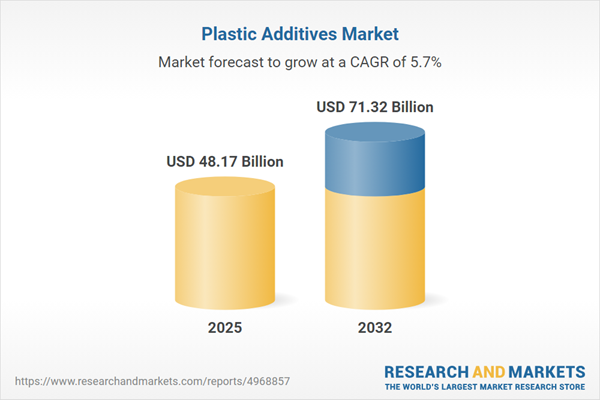Speak directly to the analyst to clarify any post sales queries you may have.
The plastic additives market is evolving rapidly as manufacturers pursue advanced solutions that combine enhanced polymer performance with compliance and sustainability. With shifting regulatory landscapes, increasing digitalization, and emerging circular economy mandates, industry stakeholders are seeking actionable market intelligence to guide investments and strategy.
Plastic Additives Market Snapshot
The Plastic Additives Market grew from USD 45.69 billion in 2024 to USD 48.17 billion in 2025. It is expected to continue growing at a CAGR of 5.72%, reaching USD 71.32 billion by 2032. This expansion is driven by increased demand for tailored performance in sectors such as automotive, electronics, construction, and healthcare, alongside the accelerated adoption of bio-based and recyclable additives.
Scope & Segmentation of the Plastic Additives Market
This report provides comprehensive segmentation and an in-depth view of industry scope. Coverage includes:
- Type: Flame retardants (halogenated and non-halogenated), Impact modifiers (acrylic blends, CPE, EPDM, MBS, SBR), Plasticizers (phthalate and non-phthalate), Processing aids (acrylics, coupling agents, lubricants, release agents, styrene-based modifiers, viscosity regulators), and Stabilizers (antioxidant blends, heat stabilizers, UV stabilizers).
- Source: Natural additives and synthetic additives.
- Product Form: Granules, liquids, and powders for application-specific requirements.
- Recyclability: Options include biodegradable, non-recyclable, and recyclable chemistries, aligning with sustainability goals.
- Plastic Type: Commodity, engineering, and high-performance plastics.
- End-User Sector: Solutions tailored for aerospace, agriculture, automotive, construction, consumer goods, electronics, food & beverage, and healthcare.
- Regional Coverage:
- Americas: United States, Canada, Mexico, Brazil, Argentina, Chile, Colombia, Peru.
- Europe, Middle East & Africa: United Kingdom, Germany, France, Russia, Italy, Spain, Netherlands, Sweden, Poland, Switzerland, UAE, Saudi Arabia, Qatar, Turkey, Israel, South Africa, Nigeria, Egypt, Kenya.
- Asia-Pacific: China, India, Japan, Australia, South Korea, Indonesia, Thailand, Malaysia, Singapore, Taiwan.
- Company Analysis: Major manufacturers include Adeka Corporation, BASF SE, Clariant International Ltd., Dow Chemical Company, Evonik Industries AG, Exxon Mobil Corporation, and others.
Key Takeaways for Senior Decision-Makers
- Technological advances, such as nanocomposite additives and smart release systems, are enabling polymers to meet stricter performance and sustainability criteria.
- Global adoption of circular economy practices and stricter environmental standards is reshaping supply chains and driving innovation in additive chemistries.
- Manufacturers are increasingly collaborating with resin suppliers to manage risks and streamline operations amidst changing market dynamics.
- Regional hotspots like Asia-Pacific are fueling demand through rapid urbanization and infrastructure projects, while established markets are focusing on R&D and regulatory compliance.
- Leading companies are diversifying portfolios via acquisitions, digital service integration, and regional manufacturing strategies to enhance local responsiveness.
- End-user demand is diversifying, with sectors like automotive and healthcare requiring additives tailored for regulatory compliance and advanced material performance.
Tariff Impact: Strategic Shifts in Sourcing and Production
Recent U.S. tariff measures have added complexity to sourcing strategies and input cost structures for plastic additives. In response, manufacturers are reevaluating supplier partnerships, expediting regional asset expansions, and ramping up domestic feedstock initiatives to enhance resilience. These shifts have also amplified the value of technical support and compliance services, enabling agile responses to evolving trade conditions.
Methodology & Data Sources
Our research is anchored in extensive secondary analysis of market literature, regulatory documents, and proprietary databases. This is complemented by primary interviews with executives and engineers, and cross-verified through financial reports, industry statistics, and customs data. Validation sessions and advanced scenario modeling ensure robust, actionable insights.
Why This Report Matters
- Uncovers how sustainability and innovation trends are redefining the competitive landscape, guiding investment and portfolio expansion.
- Provides actionable intelligence for risk mitigation, regional strategy, and strategic supply chain decisions tailored to current and future market needs.
Conclusion
The plastic additives industry is shaped by a convergence of technological progress, compliance demands, and shifting value chains. Leaders equipped with comprehensive insights are well-positioned to anticipate trends and capture emerging opportunities across this evolving market.
Additional Product Information:
- Purchase of this report includes 1 year online access with quarterly updates.
- This report can be updated on request. Please contact our Customer Experience team using the Ask a Question widget on our website.
Table of Contents
3. Executive Summary
4. Market Overview
7. Cumulative Impact of Artificial Intelligence 2025
Companies Mentioned
The companies profiled in this Plastic Additives market report include:- Adeka Corporation
- AkzoNobel NV
- Astra Polymer Compounding Co, Ltd.
- Baerlocher Group
- BASF SE
- Bio-Tec Environmental, LLC
- Clariant International Ltd.
- DuPont de Nemours, Inc.
- Eastman Chemical Company
- Emerald Performance Materials
- Evonik Industries AG
- Exxon Mobil Corporation
- Grafe Advanced Polymers GmbH
- Kaneka Corporation
- Lanxess AG
- Mitsui & Co. Plastics Ltd.
- Nanjing Union Rubber and Chemicals Co., Ltd.
- Nouryon Chemicals Holding B.V.
- Peter Greven GmbH & Co. KG
- PMC Global Incorporated
- Sabo S.P.A.
- Sakai Chemical Industry Co., Ltd.
- Solvay S.A.
- Songwon Industrial Co., Ltd.
- The Dow Chemical Company
- United Plastics Corp.
- Wuxi Jubang Auxiliaries Co., Ltd.
Table Information
| Report Attribute | Details |
|---|---|
| No. of Pages | 190 |
| Published | November 2025 |
| Forecast Period | 2025 - 2032 |
| Estimated Market Value ( USD | $ 48.17 Billion |
| Forecasted Market Value ( USD | $ 71.32 Billion |
| Compound Annual Growth Rate | 5.7% |
| Regions Covered | Global |
| No. of Companies Mentioned | 28 |









